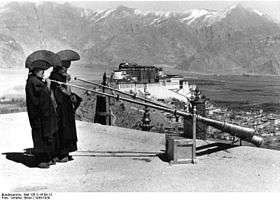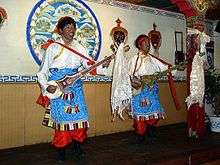Music of Tibet
The music of Tibet reflects the cultural heritage of the trans-Himalayan region, centered in Tibet but also known wherever ethnic Tibetan groups are found in Nepal, Bhutan, India and further abroad. First and foremost Tibetan music is religious music, reflecting the profound influence of Tibetan Buddhism on the culture.

The new-age 'singing bowl' music marketed in the West as 'Tibetan music' is of 1970s US origin.
History
The Lama Mani tradition – the telling of Buddhist parables through song — dates back to the 12th century. The songs were performed by wandering storytellers, who travelled from village to village, drawing on their own often humble origins to relate to people from all backgrounds. Vividly illustrated Buddhist thangka paintings depicted the narrative and helped the audience understand what was essentially a teaching.
Tibetan "street songs" were a traditional form of expression particularly popular as a means of political and other commentary in a country that was previously without newspapers or other means of mass communication. They provided political and social commentary and satire and are a good example of a bardic tradition, akin to that in medieval Europe or, more recently, the role calypsos played in the West Indies. As song lyrics in Tibet usually contained stanzas of 4 lines of 6 syllables each, the lyrics could be easily adapted to almost any melody.[1]
Secular Tibetan music has been promoted by organizations like the Dalai Lama's Tibetan Institute of Performing Arts. This organization specialized in the lhamo, an operatic style, before branching out into other styles, including dance music like toeshey and nangma. Nangma is especially popular in the karaoke bars of the urban center of Tibet, Lhasa. Another form of popular music is the classical gar style, which is performed at rituals and ceremonies. Lu are a type of songs that feature glottal vibrations and high pitches. There are also epic bards who sing of Tibet's national hero Gesar.
Popular and modern
Tibetans have a very strong popular-music culture, and are also well represented in Chinese popular culture. Tibetan singers are particularly known for their strong vocal abilities, which many attribute to the high altitudes of the Tibetan Plateau. Tseten Dolma (才旦卓玛) rose to fame in the 1960s for her music-and-dance suite "The Earth is Red". Kelsang Metok (格桑梅朵) is a popular singer who combines the vocal traditions of Tibet with elements of Chinese, Indian and Western pop. Purba Rgyal (Pubajia or 蒲巴甲) was the 2006 winner of Jiayou Haonaner (Chinese: 加油!好男儿), a Chinese reality talent show. In 2006, he starred in Sherwood Hu's Prince of the Himalayas, an adaptation of Shakespeare's Hamlet, set in ancient Tibet and featuring an all-Tibetan cast.
In the multi-ethnic provinces of Qinghai and Sichuan, whose Tibetan inhabitants are regarded as part of the "Amdo" cultural tradition, there is a very strong local scene, mostly exposed through videos on local buses. Amdo stars are among others Sherten (short for Sherab Tendzin) [2] and Yadong, who both have reached outside the borders of China with their music.
The first fusion with Western music was Tibetan Bells, a 1972 release by Nancy Hennings and Henry Wolff. The soundtrack to Kundun, by Philip Glass, has helped to popularize Tibetan music.
Foreign styles of popular music have also had a major impact within the Tibetan diaspora, where Indian ghazal and filmi are very popular and American rock has produced the India-based Rangzen Shonu. Within Tibet itself, among rock groups the bilingual Vajara (Tian Chu) sextants are the oldest and most famous act.[3] Since the relaxation of some laws in the 1980s, Tibetan pop, popularised by the likes of Yadong (Tibet), Dadon (now living in the US), Jampa Tsering (Tibet), 3-member group AJIA, 4-member group Gao Yuan Hong, five-member group Gao Yuan Feng, are well known. Gaoyuan Hong in particular has introduced elements of Tibetan language rapping into their singles. Alan Dawa Dolma is the first and currently only artist of Tibetan ethnicity to be active in both Chinese and Japanese music industry.

Western representations
Although it is sometimes stated that 'Tibetan singing bowls' date back to a pre-Buddhist, shamanic Bon-Po tradition, the manufacture and use of bowls specifically for the purpose of 'singing' (as opposed to standing bells/bowls that are intended to be struck) is believed to be a modern and non-Tibetan phenomenon.[4] The historical records and accounts of the music of Tibet are silent about singing bowls. Such bowls are not mentioned by Perceval Landon (a visitor in 1903-1904) in his notes on Tibetan music, nor by any other visitor.[4]
Wolff and Hennings' seminal recording Tibetan Bells was followed by the development of a unique style of American singing bowl music often marketed as 'Tibetan music'.[5] This has remained very popular in the US with many recordings being marketed as World music or New-age music since the introduction of those terms in the 1980s.[6] 'Tibetan singing bowls' have as a result become a prominent visual and musical symbol of Tibet,[5] to the extent that the most prevalent modern representation of Tibet within the US is that of bowls played by Americans.[7]
See also
Footnotes
- Goldstein, Melvyn C. (1982). Lhasa Street Songs: Political and Social Satire in Traditional Tibet. The Tibet Journal. Vol. VII Nos. 1 & 2. Spring/Summer 1982, pp. 56-66.
- My date with a pop star, TravelBlog 15 March 2007
- Erlich, Reese (2009-05-05). "Rock 'N' Roll At The Top Of The World". NPR. Retrieved 2013-03-16.
- Gioia, Ted (2006). Healing Songs. Durham and London: Duke University Pres. pp. 149–151.
- Congdon 2017, pp. 197-198.
- Congdon 2017, p. 125.
- Congdon 2017, pp. 214, 215.
References
- Melinda Jin. Tibetan culture more active on domestic, overseas stages, China Tibet Online, 15 November 2013.
- Crossley-Holland, Peter. (1976). "The Ritual Music of Tibet." The Tibet Journal. Vol. 1, Nos. 3 & 4, Autumn 1976, pp. 45–54.
- Congdon, Darinda (2007). Tibet Chic: Myth, Marketing, Spirituality and Politics in Musical Representations of Tibet in the United States (PDF) (Doctor of Philosophy thesis). University of Pittsburgh.CS1 maint: ref=harv (link)